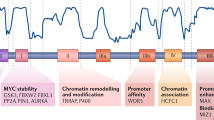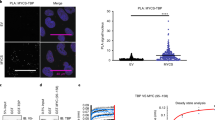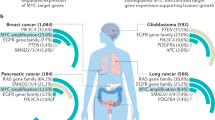Abstract
Myc is a multifunctional nuclear phosphoprotein that can drive cell cycle progression, apoptosis and cellular transformation. Myc orchestrates these activities at the molecular level by functioning as a regulator of gene transcription to activate or repress specific target genes. Previous studies have shown that both the Myc N-terminal domain (NTD) and the C-terminal domain (CTD) are essential for Myc functions. The role of the CTD is relatively well understood as it encodes a basic helix–loop–helix leucine zipper motif important for DNA binding and protein–protein interactions. By contrast, the role of the NTD and the specific domains responsible for different Myc activities are not as well defined. To investigate the regions of the NTD necessary for Myc function and to determine whether these activities are overlapping or independent of one another, we have conducted a detailed structure–function analysis of the Myc NTD. We assessed the ability of a number of deletion and point mutants within the highly conserved regions of the Myc NTD to induce cell cycle progression, apoptosis and transformation as well as repress and activate expression of endogenous target genes. Our analyses highlight the complexity of the Myc NTD and extend previous studies. For example, we show most Myc mutants that were compromised as repressors of gene transcription retained the ability to activate gene transcription, reinforcing the concept that these activities can be uncoupled. Repression of two different target genes could be distinguished by specific mutants, further supporting the notion of at least two different Myc repression mechanisms. Mutants disabled at both inducing and repressing gene transcription could not maximally drive the biological activities of Myc, indicating these functions are tightly linked. Indeed, a close association of Myc repression and apoptosis was also observed.
This is a preview of subscription content, access via your institution
Access options
Subscribe to this journal
Receive 50 print issues and online access
$259.00 per year
only $5.18 per issue
Buy this article
- Purchase on Springer Link
- Instant access to full article PDF
Prices may be subject to local taxes which are calculated during checkout






Similar content being viewed by others
References
Amati B, Brooks MW, Levy N, Littlewood TD, Evan GI and Land H . (1993a). Cell, 72, 233–245.
Amati B, Dalton S, Brooks MW, Littlewood TD, Evan GI and Land H . (1992). Nature, 359, 423–426.
Amati B, Littlewood TD, Evan GI and Land H . (1993b). EMBO J., 12, 5083–5087.
Barrett J, Birrer MJ, Kato GJ, Dosaka-Akita H and Dang CV . (1992). Mol. Cell Biol., 12, 3130–3137.
Bello-Fernandez C, Packham G and Cleveland JL . (1993). Proc. Natl. Acad. Sci. USA, 90, 7804–7808.
Birrer MJ, Segal S, DeGreve JS, Kaye F, Sausville EA and Minna JD . (1988). Mol. Cell Biol., 8, 2668–2673.
Bouchard C, Dittrich O, Kiermaier A, Dohmann K, Menkel A, Eilers M and Luscher B . (2001). Genes Dev., 15, 2042–2047.
Bouchard C, Thieke K, Maier A, Saffrich R, Hanley-Hyde J, Ansorge W, Reed S, Sicinski P, Bartek J and Eilers M . (1999). EMBO J., 18, 5321–5333.
Brough DE, Hoffman TJ, Ellmood KB, Townley RA and Cole M . (1995). Mol. Cell Biol., 15, 1536–1544.
Chang DW, Claassen GF, Hann SR and Cole MD . (2000). Mol. Cell Biol., 20, 4309–4319.
Cheng SW, Davies KP, Yung E, Beltran RJ, Yu J and Kalpana GV . (1999). Nat. Genet., 22, 102–105.
Conzen SD, Gottlob K, Kandel ES, Khanduri P, Wagner AJ, O'Leary M and Hay N . (2000). Mol. Cell Biol., 20, 6008–6018.
Dang CV . (1999). Mol. Cell Biol., 19, 1–11.
DePinho RA, Hatton KS, Tesfaye A, Yancopoulos GD and Alt FW . (1987). Genes Dev., 1, 1311–1326.
Eberhardy SR and Farnham PJ . (2001). J. Biol. Chem., 276, 48562–48571.
Facchini LM, Chen S, Marhin WW, Lear JN and Penn LZ . (1997). Mol. Cell Biol., 17, 100–114.
Feng XH, Liang YY, Liang M, Zhai W and Lin X . (2002). Mol. Cell, 9, 133–143.
Flinn EM, Busch CM and Wright AP . (1998). Mol. Cell Biol., 18, 5961–5969.
Frank SR, Schroeder M, Fernandez P, Taubert S and Amati B . (2001). Genes Dev., 15, 2069–2082.
Gartel AL, Ye X, Goufman E, Shianov P, Hay N, Najmabadi F and Tyner AL . (2001). Proc. Natl. Acad. Sci. USA, 98, 4510–4515.
Grandori C, Cowley SM, James LP and Eisenman RN . (2000). Annu. Rev. Cell. Dev. Biol., 16, 653–699.
Hirst SK and Grandori C . (2000). Oncogene, 19, 5189–5197.
Hitoshi Y, Lorens J, Kitada SI, Fisher J, LaBarge M, Ring HZ, Francke U, Reed JC, Kinoshita S and Nolan GP . (1998). Immunity, 8, 461–471.
Izumi H, Molander C, Penn LZ, Ishisaki A, Kohno K and Funa K . (2001). J. Cell Sci., 114, 1533–1544.
Kato GJ, Barrett J, Villa-Garcia M and Dang CV . (1990). Mol. Cell Biol., 10, 5914–5920.
Kuttler F, Ame P, Clark H, Haughey C, Mougin C, Cahn JY, Dang CV, Raffeld M and Fest T . (2001). Oncogene, 20, 6084–6094.
Landay M, Oster SK, Khosravi F, Grove LE, Yin X, Sedivy J, Penn LZ and Prochownik EV . (2000). Cell Death Differ., 7, 697–705.
Lee LA, Dolde C, Barrett J, Wu CS and Dang CV . (1996). J. Clin. Investi., 97, 1687–1695.
Lewis BC, Shim H, Li Q, Wu CS, Lee LA, Maity A and Dang CV . (1997). Mol. Cell Biol., 17, 4967–4978.
Li LH, Nerlov C, Prendergast G, MacGregor D and Ziff EB . (1994). EMBO J., 13, 4070–4079.
Mai S and Martensson IL . (1995). Nucleic Acids Res., 23, 1–9.
Marhin WW, Chen S, Facchini LM, Fornace Jr AJ and Penn LZ . (1997). Oncogene, 14, 2825–2834.
Mateyak MK, Obaya AJ, Adachi S and Sedivy JM . (1997). Cell Growth Differ., 8, 1039–1048.
Miltenberger RJ, Sukow KA and Farnham PJ . (1995). Mol. Cell Biol., 15, 2527–2535.
Nesbit CE, Grove LE, Yin X and Prochownik EV . (1998). Cell Growth Differ., 9, 731–741.
Nesbit CE, Tersak JM, Grove LE, Drzal A, Choi H and Prochownik EV . (2000). Oncogene, 19, 3200–3212.
Nolan GP and Shatzman AR . (1998). Curr. Opin. Biotechnol., 9, 447–450.
Oster SK, Ho CS, Soucie EL and Penn LZ . (2002). Adv. Cancer Res., 84, 81–154.
Oster SK, Marhin WW, Asker C, Facchini LM, Dion PA, Funa K, Post M, Sedivy JM and Penn LZ . (2000). Mol. Cell Biol., 20, 6768–6778.
Park DS, Razani B, Lasorella A, Schreiber-Agus N, Pestell RG, Iavarone A and Lisanti MP . (2001). Biochemistry, 40, 3354–3362.
Penn LJ, Brooks MW, Laufer EM and Land H . (1990). EMBO J., 9, 1113–1121.
Perez-Roger I, Kim SH, Griffiths B, Sewing A and Land H . (1999). EMBO J., 18, 5310–5320.
Philipp A, Schneider A, Vasrik I, Finke K, Xiong Y, Beach D, Alitalo K and Eilers M . (1994). Mol. Cell Biol., 14, 4032–4043.
Rosenwald IB, Rhoads DB, Callanan LD, Isselbacher KJ and Schmidt EV . (1993). Proc. Natl. Acad. Sci. USA, 90, 6175–6178.
Shim H, Dolde C, Lewis BC, Wu CS, Dang G, Jungmann RA, Dalla-Favera R and Dang CV . (1997). Proc. Natl. Acad. Sci. USA, 94, 6658–6663.
Small MB, Hay N, Schwab M and Bishop JM . (1987). Mol. Cell Biol., 7, 1638–1645.
Staller P, Peukert K, Kiermaier A, Seoane J, Lukas J, Karsunky H, Moroy T, Bartek J, Massague J, Hanel F and Eilers M . (2001). Nat. Cell Biol., 3, 392–399.
Stone J, de Lange T, Ramsay G, Jakobovits E, Bishop JM, Varmus H and Lee W . (1987). Mol. Cell Biol., 7, 1697–1709.
Wang X, Peters MA, Utama FE, Wang Y and Taparowsky EJ . (1999). Mol. Endocrinol., 13, 254–267.
Watanabe Ki K, Ozaki T, Nakagawa T, Miyazaki K, Takahashi M, Hosoda M, Hayashi S, Todo S and Nakagawara A . (2002). J. Biol. Chem., 13, 13.
Xiao Q, Claassen G, Shi J, Adachi S, Sedivy J and Hann SR . (1998). Genes Dev., 12, 3803–3808.
Xu D, Popov N, Hou M, Wang Q, Bjorkholm M, Gruber A, Menkel AR and Henriksson M . (2001). Proc. Natl. Acad. Sci. USA, 98, 3826–3831.
Yang W, Shen J, Wu M, Arsura M, FitzGerald M, Suldan Z, Kim DW, Hofmann CS, Pianetti S, Romieu-Mourez R, Freedman LP and Sonenshein GE . (2001). Oncogene, 20, 1688–1702.
Acknowledgements
We thank Elizabeth Flinn, Martin Eilers, Jim Woodgett and Ed Prochownik for providing mutant Myc constructs. We also thank the members of the Penn Lab for helpful suggestions. This work was supported by a grant from the National Cancer Institute of Canada (NCIC) with funds from the Canadian Cancer Society (LZP) as well as scholarships from the NCIC with funds from the Terry Fox Foundation (SKO), the Canadian Institute for Health Research (SKO), and the Natural Sciences and Engineering Research Council of Canada (DYLM).
Author information
Authors and Affiliations
Corresponding author
Rights and permissions
About this article
Cite this article
Oster, S., Mao, D., Kennedy, J. et al. Functional analysis of the N-terminal domain of the Myc oncoprotein. Oncogene 22, 1998–2010 (2003). https://doi.org/10.1038/sj.onc.1206228
Received:
Revised:
Accepted:
Published:
Issue Date:
DOI: https://doi.org/10.1038/sj.onc.1206228
Keywords
This article is cited by
-
MYC: a multipurpose oncogene with prognostic and therapeutic implications in blood malignancies
Journal of Hematology & Oncology (2021)
-
MYCL promotes iPSC-like colony formation via MYC Box 0 and 2 domains
Scientific Reports (2021)
-
Conservative route to genome compaction in a miniature annelid
Nature Ecology & Evolution (2020)
-
Emerging roles of Myc in stem cell biology and novel tumor therapies
Journal of Experimental & Clinical Cancer Research (2018)
-
Lysine-52 stabilizes the MYC oncoprotein through an SCFFbxw7-independent mechanism
Oncogene (2017)



